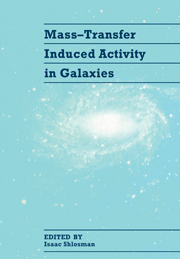Book contents
- Frontmatter
- Contents
- Preface
- List of Participants
- I INTRODUCTION
- II THE INNER PARSEC
- III THE CIRCUMNUCLEAR REGION
- IV GAS DYNAMICS AND STAR FORMATION IN BARRED AND NORMAL GALAXIES
- V NUCLEAR GAS AND LARGE-SCALE PROPERTIES OF AGN AND STARBURST HOSTS
- VI HOST GALAXY-AGN-NUCLEAR STARBURST CONNECTION
- VII GALAXY INTERACTIONS AND INDUCED ACTIVITY
- VIII GAS DYNAMICS IN ELLIPTICALS
- IX AGN AND STARBURST HOSTS AT LARGE REDSHIFTS
- X CONFERENCE SUMMARY
- Inflows and Outbursts in Galaxies
- Subject Index
- Object Index
- Author Index
Inflows and Outbursts in Galaxies
Published online by Cambridge University Press: 05 May 2010
- Frontmatter
- Contents
- Preface
- List of Participants
- I INTRODUCTION
- II THE INNER PARSEC
- III THE CIRCUMNUCLEAR REGION
- IV GAS DYNAMICS AND STAR FORMATION IN BARRED AND NORMAL GALAXIES
- V NUCLEAR GAS AND LARGE-SCALE PROPERTIES OF AGN AND STARBURST HOSTS
- VI HOST GALAXY-AGN-NUCLEAR STARBURST CONNECTION
- VII GALAXY INTERACTIONS AND INDUCED ACTIVITY
- VIII GAS DYNAMICS IN ELLIPTICALS
- IX AGN AND STARBURST HOSTS AT LARGE REDSHIFTS
- X CONFERENCE SUMMARY
- Inflows and Outbursts in Galaxies
- Subject Index
- Object Index
- Author Index
Summary
INTRODUCTION
A wealth of information has been presented at this conference illustrating the basic theme that large-scale gas inflows can result in the release of large amounts of energy in galactic nuclei by starbursts and by non-thermal processes associated with black hole accretion. Particular attention has been paid to two situations in which such phenomena frequently occur: (1) bar-driven inflows in barred spiral galaxies can lead to gas accumulation and star formation in nuclear rings of ‘hot spots’, and (2) tidal interactions and mergers between galaxies can cause large amounts of gas to fall rapidly into their nuclei and produce luminous starburst and non-thermal activity. Although it is difficult to observe the gas inflows themselves directly, partly because they may be masked by more conspicuous outflows, inflows are commonly predicted by numerical simulations of barred and interacting galaxies, and the success with which these simulations match many of the observed properties of such systems leaves little doubt that inflows occur quite generally whenever a non-axisymmetric gravitational potential is present. Evidence that gas inflows from regions of galactic size are responsible for triggering the most energetic outbursts of activity in galactic nuclei is provided by the fact that in many of the most luminous systems, an amount of molecular gas comparable to the gas content of an entire large spiral galaxy is observed to be concentrated into a small nuclear region only a few hundred parsecs across.
- Type
- Chapter
- Information
- Mass-Transfer Induced Activity in Galaxies , pp. 489 - 495Publisher: Cambridge University PressPrint publication year: 1994
- 1
- Cited by

